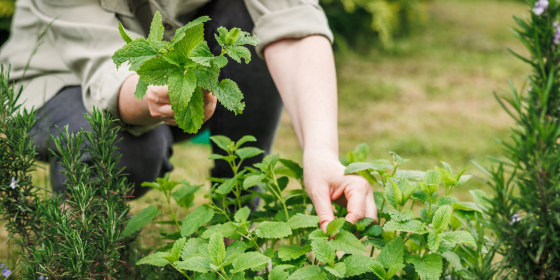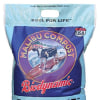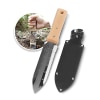Everything you need to start an herb garden, according to experts





To have a successful herb garden, you’ll need the right materials. Our experts recommend this list include products from each of the following categories:
“Herb seeds are readily available and there is no need to be choosy,” says Hooper. You can find seeds for your herb garden at the grocery store, farmer’s market, nursery or for free at your local seed library, according to our experts. That said, Sarah Akovic (a regenerative farmer and greenhouse manager at Case Western Reserve University) recommends using organic, non-GMO seeds when possible, as most big box stores spray their plants with pesticides that kill pollinators.
Akovic recommends High Mowing seeds because they’re certified organic and non-GMO. This retailer has dozens of herb seeds to choose from (including basil), and you can filter by category, type and days to maturity. The brand chooses its source plants using aroma, flavor and disease resistance to improve quality and resilience, according to High Mowing.
Akovic also recommends organic herb seeds from Fedco. Based out of Maine and specializing in gardening, Fedco is a consumer-owned cooperative, meaning that workers and customers own the business together and share annual profits. The site sells over 50 types of herb seeds, all of which are non-GMO and many of which are certified organic.
If you don’t want to start from a seed, you can get a leg up on your herb garden with already-sprouted plants. Our experts recommend buying these in person rather than online since big-box stores often get their plants from sources outside your grow zone. When in doubt, visit a nearby nursery to buy your plants; they’ll have advice about growing in your specific climate and hardiness zone, according to Wilhelmi. (Hardiness zone refers to your geographical location, which will determine if and when certain plants are most likely to thrive.) However, if you must buy online, the shipping option below keeps your hardiness zone in mind and has a plant guarantee.
In the past, I’ve ordered live herbs from The Growers Exchange, and the plants were healthy and flourishing when they arrived on my doorstep. Shipping times depend on your hardiness zone, so your plants arrive at the ideal time to maximize success, according to the brand. The site’s curated herb kits have multiple live herbs grouped by interest, such as a pollinator collection, an herb cocktail garden and an herbal tea and beverage collection. If you’d rather individually choose your varieties, the site also has a page of over 150 herbs listed in alphabetical order. The brand also has a guarantee in place so you can get a replacement or store credit if your plants arrive damaged or if they fail within 14 days of arrival.
While you can technically use any type of soil to grow herbs, most of our experts recommend choosing potting soils that are “rich in organic matter and well-draining,” says Stout. High-quality potting soils may have compost, mulch or perlite to keep the soil moist but not too moist, according to our experts. If adding these materials yourself, Akovic recommends a one-to-one ratio of compost and potting soil.
On the other hand, most of our experts say that fertilizers aren’t necessary for herbs, especially if you’re starting with rich potting soil. However, if your plants are struggling or you want better success, you should feed your herbs monthly with an organic fertilizer, says Wilhelmi.
Fertilizers are classified using three numbers, which represent the ratio of nitrogen, phosphorus and potassium, and the ideal ratio for herbs is less than 6-6-6, says Stout. “If you want to give them a good start when first planted, a 3-3-3 balanced fertilizer does the job,” says Hooper.
“Malibu Compost brand makes a great potting soil (Baby Bu’s) suitable for herbs,” says Wilhelmi. “It’s not cheap but it’s the best on the market.” The soil has 25% compost to hold moisture but still allow for drainage, and it’s organic, non-GMO and made without pesticides, according to the brand. This bag has 12 quarts of soil and is suitable for pots and outdoor garden beds.
For a lower-cost alternative, Wilhelmi recommends FoxFarm Ocean potting soil, which comes in a 12-quart bag. It’s ready to use out of the bag because it’s pH-balanced and has a blend of moss, fish meal and earthworm castings, which help the soil retain moisture and nourish plants, according to the brand. It has a 4.7-star rating from over 4,000 reviews on Amazon.
Both Akovic and Wilhelmi recommend Down to Earth fertilizer because it’s certified USDA organic and comes in a 5-pound recyclable, unbleached box that you can turn into compost. The formula is enriched with nutrients to improve the fragrance and quality of any herbs and vegetables you choose to grow, according to the brand. Per our experts’ suggestions, it has a 4-4-4 N-P-K formula (more on that below) and you can use it once a month to boost your herbs’ growth.
When shopping for containers, here’s what to keep in mind:
These pots have a 4.5-star rating from over 6,000 Amazon reviewers, and they meet all of our experts’ criteria for a reliable herb-growing container: They have drainage holes with a removable snap tray, they’re made from lightweight polypropylene (plastic) and they come in 8-inch diameters and larger. They’re also suitable for both indoor and outdoor use, according to the brand. You can get them in six sizes, five colors and two shapes, plus they come in a pack of two for a reasonable price.
If growing herbs outdoors, Stout loves using half-wine barrels because they allow room for up to five 4-inch-pot herbs. This set of two includes a 19.5-inch barrel and a 15-inch barrel, both made from oil-treated acacia wood with a metal band, so they’re durable enough for outdoor use, according to the brand. They also have detachable feet for stability.
“Have a good pair of shears, gloves that fit well, and a hand trowel,” says Wilhelmi, who prefers metal tools with as close to one-piece construction as possible because they are more durable and long-lasting. “This is pretty much all you need to grow herbs.”
Hooper, who likes tools with wooden handles to improve grip, also recommends a small watering can with a spout that can reach under the delicate leaves, so you don’t crush them while watering.
“My go-to tool for planting anything that comes in a 1-gallon size or smaller is the Hori Hori,” says Stout. Made from stainless steel with a wooden handle, this multipurpose gardening tool functions as a hand trowel, a measuring stick with inch markings on the blade and a weeding knife with both serrated and straight edges. It also includes a leather sheath.
Felco #6 pruning shears come recommended by Wilhelmi for anyone with small hands: “They are an investment, but you’ll never need to buy another pair for the rest of your life,” she says. They have rotating aluminum handles with rubberized grips for comfort and the blades are made from steel for clean, precise cuts, according to the brand. They also have a narrow, pointed tip that helps you clip close to the stem when cutting herbs.
Wilhelmi also recommends Corona pruning shears, which are less expensive than Felco, but have a similar pointed steel tip and rubberized nonslip handles. You can sharpen the blade to keep it in optimal condition as the years go on, and the hook-shaped design helps you get close to the stem, according to the brand. They also come in multiple sizes depending on the size of your hands and herbs.
Wilhelmi recommends Atlas gloves when gardening because they fit close to the hand, which helps with dexterity, and they have a grippy exterior that helps you pick up tiny seeds with ease. The lint-resistant liner also breathes and wicks sweat to keep your hands dry and comfortable while you work, according to the brand. These come in a pack of four pairs and are available in: small, medium and large sizes.
For herbs, Hooper recommends a small watering can with a wooden handle and a long spout, so it’s comfortable to hold and can water plants at the stem to avoid crushing the leaves. This 35-ounce watering can fits that description and has a 4.8-star average rating from over 1,300 reviews on Amazon. The body is made from powder-coated steel in your choice of four colors, while the handle is made from pine wood, plus it has a long, curved spout for precise watering.
At NBC Select, we work with experts who have specialized knowledge and authority based on relevant training and/or experience. We also take steps to ensure all expert advice and recommendations are made independently and without undisclosed financial conflicts of interest.
I'm a writer, editor and consultant who has a decade of experience in e-commerce. I've written home and outdoor content for publications such as Bustle, Elite Daily, CNN, Food & Wine, Lonny and Better Homes & Gardens. For this article, I interviewed a farmer, a landscaper and two gardeners.
Catch up on NBC Select’s in-depth coverage of tech and tools, wellness and more, and follow us on Facebook, Instagram, Twitter and TikTok to stay up to date.